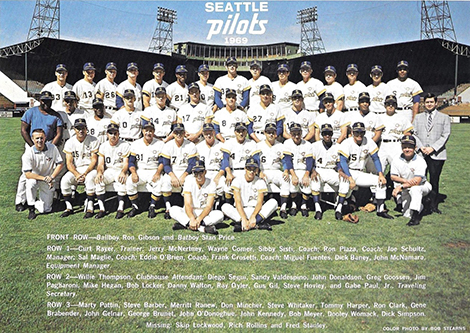If not for too many obstacles stacked up against Seattle’s first Major League Baseball team, the Pilots might very well be a month into the 2022 season right now instead of the Mariners.
Depending on their age, baseball fans have either distant memories or none at all of the beleaguered Pilots, who played their one and only season in 1969. A year later, the franchise was moved half way across the country to Wisconsin and became (and still are) the Milwaukee Brewers.
The abrupt move followed legal wrangling in efforts to block the sale of the team and keep it in Seattle. Then came an eight-year stretch of more court proceedings aimed at holding baseball’s powers-that-be responsible for the Pilots’ demise and getting another team for Seattle, which eventually happened with the launch of the Mariners in 1977.
So what made the Pilots go so wrong? Shaky team finances. Ownership that couldn’t build a solid operation. A home stadium that was a minor-league ballpark masquerading (poorly) as a big-league venue. Combined, they doomed the Pilots virtually from the start. And a predictably bad win-loss record helped seal their fate.
The story began with Seattle as a potential jewel for expansion of Major League Baseball (MLB). The city anchored the third-largest metropolitan area on the West Coast, had a long history of supporting minor league baseball, and a group pushing for an MLB team that was headed by Dewey Soriano, a former pitcher and executive for minor league teams and ex-president of the Pacific Coast League, which included the Seattle Rainiers.
Existing MLB teams that were looking for greener pastures flirted in the 1960s with moving to Seattle, but instead the American League (AL) granted the city an expansion team. It was originally scheduled to start playing in 1971, but the debut was moved up two years because of political pressure from Missouri. The AL had also given Kansas City an expansion club to replace that city’s longtime team, the Athletics, who moved to Oakland in 1968. Stuart Symington, a then-U.S. senator (and a powerful one) for Missouri, objected to his state being told to wait three years for a new team and threatened legal and political trouble for MLB unless there was an earlier start. AL bosses, not wanting the new teams to enter the league in different years, switched the starts for Kansas City and Seattle to 1969.
Voters in King County, on the promise that MLB would come, approved a bond measure in 1968 for funding for the construction of the Kingdome, a domed stadium that would house baseball. The Kingdome wouldn’t be built in time for the Pilots, though, so that left a renovated Sicks Stadium as their temporary, inaugural home. As a condition for getting a franchise, the team’s owners promised the American League they would expand seating at the 31-year-old minor-league ballpark to 30,000. Only 19,500 were ready for opening day in April, and there were 25,000 by June, when the additions stopped. The place lacked other Major League amenities, and for games that drew more than 10,000 spectators, low-water pressure caused problems for toilets in restrooms.
With the Pilots playing losing ball most of the time (their final record was 64-98, last place in their division) and in a sub-standard venue, fan attendance was predictably low—but surprisingly not the worst. The Pilots drew 677,944 spectators to 81 home games, 20th-best among the 24 MLB teams and better than the Cleveland Indians, Chicago White Sox, Philadelphia Phillies and San Diego Padres. But the numbers were paltry and hurt the club’s bottom line, which wasn’t great to begin with. Right from the start, the Soriano-led ownership group needed the then-owner of the Indians (since renamed the Guardians) to finance much of the franchise purchase price.
With money drying up and no decent place to play for years to come, the Pilots’ future was bleak as the 1969 season wound down. Soriano began negotiations for the team to be sold and moved to Milwaukee. The deal went down for $10.8 million, but not without a fight. Soriano’s ownership partners rejected it under pressure from Washington’s U.S. senators, Henry Jackson and Warren Magnuson. Prospective new owners tried to buy the team but couldn’t pull the financing together or get the approval of other MLB team owners.
By the spring of 1970, court battles waged over the Pilots custody included a state-won court injunction temporarily blocking the sale. And the state, the city and King County jointly sued the American League for alleged breach of contract. None of that stopped the Pilots from heading east.
But the news eventually got better for Seattle-area baseball fans. The lawsuit continued until 1976, when the AL agreed to give Seattle another expansion team in exchange for dropping the case. During that time, the county—confident of baseball’s return—finished building the Kingdome, where the Mariners made their debut in 1977 wearing uniforms with the same blue-and-gold colors as the Pilots’.
Since then, the Kingdome and Sicks Stadium have been demolished, and many of the people involved in the story of a rag-tag, short-lived team are out of baseball or have passed away, Like a home run knocked out of the park, the Pilots are long gone, too. But not forgotten.
